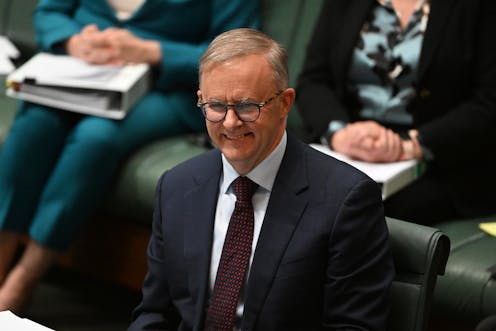First Newspoll since election gives Albanese 'honeymoon' ratings; Australia's poor success rate at referendums
- Written by Adrian Beaumont, Election Analyst (Psephologist), The Conversation

The first Newspoll since the May federal election, conducted July 27-30 from a sample of 1,508, gave Labor a 56-44 lead (52.1-47.9 to Labor at the election). Primary votes were 37% Labor (32.6% at election), 33% Coalition (35.7%), 12% Greens (12.2%), 6% One Nation (5.0%), 2% UAP (4.1%) and 10% for all Others (10.5%).
Prime Minister Anthony Albanese’s satisfaction rating was 61% (up 20 since the final pre-election Newspoll) and his dissatisfaction rating was 26% (down 20). That gave Albanese a net approval of +35, up 40 points.
The Poll Bludger[1] said Albanese’s net approval is the highest for a PM since early in Malcolm Turnbull’s tenure after he toppled Tony Abbott[2] in September 2015. Prior to Turnbull, Kevin Rudd in October 2009 was the last to exceed Albanese’s net approval.
Albanese has a higher “satisfied” rating than any other new PM after a change of government election. But Newspoll has changed its methods since Rudd was PM, resulting in a lower undecided vote on the PM’s ratings. Net approval should be used for comparison with past PMs.
Opposition Leader Peter Dutton’s initial ratings were 41% dissatisfied, 37% satisfied (net -4). In comparing debut ratings for opposition leaders since 2006, The Poll Bludger said Dutton’s net approval was worse than all except Albanese, who had a -5 net approval in his first poll as opposition leader.
Albanese led Dutton by 59-25 as better PM, which The Poll Bludger says is the widest gap since early 2008 under Rudd. Now that we have a Labor PM, this measure will skew towards Albanese. Better PM skews to incumbents, not parties.
These ratings for Albanese are ‘honeymoon’ ratings that are likely to fade as more opposition builds to his agenda. High inflation is likely to damage Albanese and Labor if it persists.
Read more: Final 2022 election results: Coalition routed in cities and in Western Australia – can they recover in 2025?[3]
Essential: should the Greens support Labor’s 43% emissions reduction target?
In an Essential poll[4], conducted in the days before July 26 from a sample of 1,082, 50% thought the Greens should vote for Labor’s policy to reduce greenhouse gas emissions by 43% by 2030, 25% thought the Greens should only vote for Labor’s policy if Labor agrees to changes to bring it closer to Greens policy, and 25% said they did not want further action on climate change.
68% of those who voted Labor at the federal election wanted Labor’s current policy, while just 22% thought Labor should shift towards the Greens’ position. Among Greens voters, 52% thought Labor should shift while 40% did not.
Among the 75% who wanted further climate change action, 44% thought the 43% target is a sufficient contribution from Australia to limit the impact of climate change, while 40% thought more needs to be done.
Voters rated the new Labor government good at handling COVID by 36-27, education by 35-18 and climate change by 33-21. But Labor received a poor rating on cost of living (41-23 poor).
Well over 50% thought the federal government had a lot or a fair amount of influence over various economic issues, implying that voters will blame the government for a poor economy. Labor will hope inflation is under control and the economy is doing better by the 2025 election.
Just eight of 44 constitutional referendums have succeeded
Albanese has proposed a referendum[5] to recognise an Indigenous Voice to Parliament in the Australian Constitution. Our constitution can only be changed by referendum, with a majority of the overall vote and a majority in a majority of the states (so four of the six states).
Just eight of the 44 referendums proposed[6] since federation in 1901 have succeeded. Another five would have succeeded if only a simple popular vote majority had been required, but failed as at least three states were opposed.
The last constitutional referendums were in 1999, when a referendum on becoming a republic failed. The last successful referendums were in 1977, which required the replacement of a casual Senate vacancy with someone from the same party.
Australia has also had four non-constitutional referendums (plebiscites), where the law could have been altered by legislation alone but a public vote was desired. The successful same-sex marriage plebiscite in 2017 was the most recent.
The other three plebiscites were two narrowly defeated conscription plebiscites in the First World War and the plebiscite that chose Advance Australia Fair as our national song in 1977.
The one previous occasion in which a referendum on Indigenous rights was proposed resulted in a record “Yes” vote of over 90% at the 1967 referendum[7]. The same-sex marriage plebiscite[8] had a 61.6% Yes vote nationally, easily winning in every state.
Previous referendums have mostly involved proposals to reform our system of government. It’s likely the high failure rate is because voters take the attitude that if it ain’t broke, don’t fix it. Partisan politics is also a factor, and if the Coalition opposes the Voice, the chance of a successful referendum drops.
References
- ^ Poll Bludger (www.pollbludger.net)
- ^ toppled Tony Abbott (en.wikipedia.org)
- ^ Final 2022 election results: Coalition routed in cities and in Western Australia – can they recover in 2025? (theconversation.com)
- ^ Essential poll (essentialreport.com.au)
- ^ proposed a referendum (www.abc.net.au)
- ^ referendums proposed (en.wikipedia.org)
- ^ 1967 referendum (en.wikipedia.org)
- ^ same-sex marriage plebiscite (en.wikipedia.org)

















